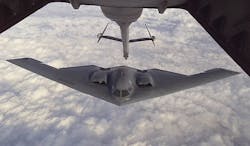Rockwell Collins builds very low frequency (VLF) military communications for B-2 stealth bomber
WRIGHT-PATTERSON AFB, Ohio –Military communications experts at the Rockwell Collins Government Systems segment in Cedar Rapids, Iowa, are starting full-rate production of a secure and jam-resistant very low frequency (VLF) radio for the U.S. Air Force B-2 stealth bomber to enable the aircraft crew to communicate with national command authorities while on long-range missions.
Officials of the Air Force Life Cycle Management Center at Wright-Patterson Air Force Base, Ohio, are awarding a $12.9 million contract to Rockwell Collins for full-rate production of increment 1 of the Common Very Low Frequency Receiver (CVR) program.
U.S. strategic bombers typically communicate over UHF satellite communications (SATCOM) links, as well as the MILSTAR SATCOM system. These SATCOM links, however, are nearing the end of their anticipated life cycles, and their strategic communications replacement, the Advanced Extremely High Frequency (AEHF) SATCOM system, will not be ready for several years.
Rockwell Collins began full-scale development of the CVR in late 2013, which involved modifying, qualifying, and testing a B-2 bomber VLF communications system, consisting of a terminal and receiver, antenna, human machine interface (HMI) display, and ancillary cabling, rack, and equipment to enable receipt and display of emergency action messages.
Related: Raytheon to upgrade communications cyber security for Air Force B-2 bomber SATCOM
Over the past four years Rockwell Collins experts also have performed systems engineering and requirements definition, prototype fabrication, qualification testing, airworthiness certification, and flight testing of the B-2 bomber's CVR.
Very low frequency communications are among the most durable and reliable communications modes for military use. Although VLF sends data relatively slowly, it is designed to survive and operate through nuclear explosions.
The CVR that Rockwell Collins is building for the B-2 bomber will bridge between the UHF SATCOM and MILSTAR systems and the future AEHF SATCOM system, Air Force officials say.
Rockwell Collins has developed the B-2's VLF communications system over the last four years with an objective of making the system available for the B-2 fleet by as early as this year. This timeframe allows for only a modification and qualification program, not a full development program, Air Force officials say.
Related: Air Force scours industry for replacement part to nuclear bomber communications system
Rockwell Collins engineers have designed the B-2 CVR system to operate in the airborne nuclear combat environment, be secure, and be survivable, Air Force officials say. It is nuclear hardened and meets stringent cryptographic requirements.
Development and production of the B-2 bomber's CVR has been delayed for a quarter-century. The CVR originally was conceived in 1992 as a successor to the VLF communication system originally slated to be included with the B-2's communication package. The original system was deferred in 1992 because of budget constraints.
Today the B-2 uses a UHF satellite communications (SATCOM) system. The Rockwell Collins CVR will enable the B-2 to receive VLF signals bounced off of lower levels of the atmosphere, bypassing the satellite relay. This would ensure the B-2 remains a viable nuclear weapon system until the U.S. military can deploy next-generation strategic SATCOM.
On this contract Rockwell Collins will do the work in Richardson, Texas, and should be finished by March 2019. For more information contact Rockwell Collins online at www.rockwellcollins.com, or the Air Force Life Cycle Management Center at www.wpafb.af.mil/aflcmc.
Learn more: search the Aerospace & Defense Buyer's Guide for companies, new products, press releases, and videos

